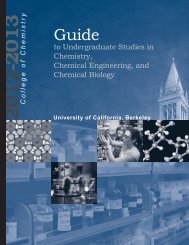Newsjournal body.qxp - College of Chemistry - University of ...
Newsjournal body.qxp - College of Chemistry - University of ...
Newsjournal body.qxp - College of Chemistry - University of ...
You also want an ePaper? Increase the reach of your titles
YUMPU automatically turns print PDFs into web optimized ePapers that Google loves.
translating their technical knowledge into presentations that are appropriate<br />
for elementary classrooms. “That is where we come in,” said Brown.<br />
Added Pauzanshie, “It’s a perfect match because graduate students are<br />
quite flexible and can make time to have some fun.” Pauzanshie gets third<br />
graders thinking about phase transitions and state change using both dry<br />
ice and liquid nitrogen. “The children love the liquid nitrogen experiments,<br />
since it looks like water but evaporates instantly when poured out <strong>of</strong> its<br />
container.” And to show the few skeptics that the liquid was indeed quite<br />
cold, he dunked a flower in the liquid and proceeded to shatter it, to the<br />
amazement and amusement <strong>of</strong> the onlookers.<br />
Many <strong>of</strong> the demonstrations from the graduate students are focused on<br />
larger issues, beyond pure chemistry, such as soil science and ecosystems, to<br />
impart a broader perspective to the students. “Everything is related” is how<br />
Amber Wise describes her message. She plays games with the children to<br />
teach them about the circle <strong>of</strong> life. First Wise, a chemistry graduate student,<br />
she assigns everyone to be an object in the ecosystem. “They get to be things<br />
like air, soil, water, people and plants. One child takes a ball <strong>of</strong> yarn, holds<br />
the loose string, and tosses the ball to another child whose assigned element<br />
connects with their own, such as tree connecting to soil, and then explains<br />
the connection. In the end we make a big interlocking web, to illustrate<br />
that everything is interdependent.”<br />
Not your grandma’s high school<br />
LOVE LETTERS. Children from Cragmont Elementary<br />
in Berkeley responded to Peter Pauzanshie’s<br />
presentation <strong>of</strong> “Liquids, Gases, Solids and Goo.” “It was<br />
cool when you put the flower into the liquid nitrogen.<br />
But the goo was the coolest. I am going to make it<br />
at my house. When I grow up, maybe I want to be<br />
a scientist. It would be cool.”<br />
Connections are a big part <strong>of</strong> the Nano*High message as well, although<br />
its lessons dwell more on interactions at the nanoscale. (The asterisk refers<br />
to an interesting bit <strong>of</strong> information: “the human hair is 50,000 nanometers<br />
across.”) Nano*High at LBNL was started as a mechanism to get high school<br />
students more interested in science, according to organizer Mark Alper,<br />
. . . . . . . . . . . . . . . . . . . . . . . . . . . . . . . . . . . . . . . . . . . . . . . . . . . . . . . .NEWSJOURNAL 2005<br />
MaryAnn Malkos photo<br />
13




